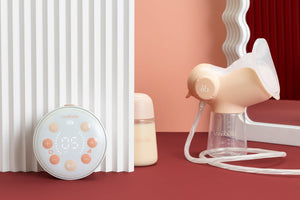Breastfeeding offers a host of benefits. The price tag attached to milk‑storage containers, breast pumps and their replacement parts can climb quickly. Starting in 2025, an increasing number of mothers can tap into pre‑tax savings vehicles – Health Savings Accounts (HSAs) and Flexible Spending Accounts (FSAs) – to shave off those costs as pumps and lactation gear count, as medical expenses.
This 2025 guide, walks mothers through the steps to unlock tax‑free savings and pinpoints exactly when breast‑pump costs become eligible for reimbursement under an FSA or HSA. With the resources in place, moms can spend less time thinking about the cost and more time holding and feeding their babies.
Understanding the Basics: FSA and HSA Explained
Both FSAs and HSAs allow mothers to pay for healthcare expenses with pre-tax dollars. This approach lightens the tax burden and cuts the total cost. While their goals are similar, the rules differ.
An FSA (Flexible Spending Account) is a benefit offered by employers. Contributions come from paychecks before taxes, making each dollar go further. However, the funds must be used within the plan year or a short grace period – otherwise, they expire. FSAs don’t require a specific health plan, making them suitable for short-term medical expenses like postpartum care or breastfeeding supplies.
An HSA (Health Savings Account) can only be established when the participant is enrolled in a health plan (HDHP). Funds in an HSA roll over from year to year and never expire. They can even grow through investment options. HSAs are portable, meaning they stay with the mother even if her job changes. Both accounts may be used to pay for medical costs, such as breast‑pumps and the associated supplies. In effect this setup gives families a degree of financial flexibility throughout the breastfeeding journey.
The IRS Ruling: Are Breast Pumps Qualified Medical Expenses?
When the IRS talks about care it means any expense that helps diagnose treat or prevent illness, or that influences the body’s normal functioning. Under IRS Publication 502 and Announcement 2011-2014, breast pumps and lactation supplies were officially classified as medical care because they directly support a mother’s ability to feed her baby. That ruling lets both Flexible Spending Accounts (FSAs) and Health Savings Accounts (HSAs) reimburse those costs tax‑free.
Under the policy the only items that qualify are the breast‑pump devices themselves – whether manual, electric or wearable – well as the accompanying storage bottles and tubing. However, non-medical accessories, such as decorative bags or clothing, remain excluded. By drawing this line, the program ensures that mothers can claim aid for the essential equipment that truly affects their own well‑being and the infant’s nutritional intake.
What’s Covered: Eligible Breast Pump-Related Expenses
Mothers can use their FSA or HSA funds to pay for a wide range of breastfeeding essentials that qualify as medical expenses, such as:
- Manual, electric or wearable breast pumps are available.
- Replacement parts such as valves, membranes, or tubing.
- Milk storage bags and bottles, any containers that keep expressed milk safely preserved.
- Nursing pads and nipple shields (if medically necessary).
- Cleaning brushes, pump-safe soaps and sanitizing wipes.
Still not every product marketed for breastfeeding actually qualifies. The items that don’t make the cut are:
· Regular baby bottles or formula.
· Decorative or branded pump bags and other lifestyle accessories.
· Extended warranties or cosmetic upgrades.
Mothers should keep receipts and the manufacturer’s details, for their records, having proof of purchase keeps the reimbursement process running smoothly.
How to Pay: Using Your FSA or HSA for a Breast Pump
Mothers can tap pre‑tax dollars for a breast pump, in two ways. First, purchase directly from an approved retailer that accepts FSA or HSA cards. These transactions process automatically when the item is listed as “FSA/HSA eligible.”
Second front the cost yourself before filing a reimbursement claim with your plan administrator. Keep an itemized receipt showing the product name and cost. Some plans may also require a doctor’s note to verify the item’s purpose.
Many major retailers now simplify this process. At Target Walgreens and even Amazon items feature a clear “FSA/HSA Eligible” badge on their listings letting shoppers move forward with confidence. Always verify the merchant code and keep receipts for proof – some online platforms still can’t process FSA or HSA payments directly.
Limits and Rules to Know in 2025
Each year, the IRS tweaks the contribution caps on both accounts. For 2025, the FSA limit is approximately $3,200, while the HSA limit is $4,300 (individuals) and $8,650 (family). FSA funds need to be used up before the plan year ends. Some employers, however, offer a brief 2½-month grace period or a small carry-over, so always check your company’s policy.
HSAs, however, roll over indefinitely and can even earn investment growth. HSA dollars can also be employed to pay for breastfeeding costs incurred by a partner or a dependent listed on your tax return. Reviewing your plan rules early ensures every eligible dollar goes toward your breastfeeding and postpartum care.
Maximizing Your Tax Benefits
Smart planning helps mothers stretch every pre-tax dollar. By aligning FSA or HSA spending with open‑enrollment windows or the expected childbirth timelines. This ensures funds are available when a major expense (such as a new breast pump) pops up.
Use your FSA for short-term needs such as replacement parts or storage bags, since those funds typically expire yearly. For ongoing expenses park the money in your HSA; the balance carries forward and can even pick up interest or be invested.
Combine insurance coverage with FSA or HSA reimbursement whenever possible to minimize out-of-pocket costs. Keep digital receipts and documentation for easy claims. For high earners, HSAs can double as retirement accounts; withdraw tax-free for medical expenses, or after age 65 like an IRA. Even a modest $400 breast pump can carve out $100 in tax savings contingent on the taxpayer’s marginal bracket.
Common Mistakes and How to Avoid Them
Even the most organized mothers can run into FSA or HSA issues. The most common mistake is losing receipts, which can lead to reimbursement denial. Make it a habit to keep every itemized receipt and back it up digitally.
Avoid buying before your coverage starts, as early purchases are often ineligible. And keep in mind that only medical‑grade breastfeeding supplies count; everyday bottles or accessories usually won’t qualify.
Track FSA deadlines carefully to avoid expiring funds and check plan details before purchasing. Finally, never submit the expense to both insurance and an FSA/HAS – double‑dipping can spark tax headaches later.
Real-Life Example: From Purchase to Tax Return
Sarah, a new mother in 2025, purchases a wearable breast pump for $350 and essential supplies for $80. She swipes her HSA debit card making the purchase a tax‑free medical expense. Her insurance reimburses $250 for the pump, leaving $180 covered by her HSA balance. That slice of the bill saves her 25 % in taxes compared to paying out of after‑tax dollars.
By orchestrating her insurance plan with her HSA benefits Sarah trims the cost of breastfeeding. Meticulous planning and diligent documentation let her wring out every saving. Thankfully, making her feeding journey into a far more affordable experience.
Empowering Mothers with Financial Clarity
Breastfeeding supplies aren’t just necessities – they’re smart, tax-advantaged health investments. Using FSA or HSA dollars to buy a breast pump lets a mother cut costs while still giving her baby the nutrition it needs. Understanding breast pump FSA eligibility ensures compliance with 2025 IRS healthcare rules and maximizes benefits. Keep organized records, review your plan’s guidelines, and use every eligible option. very dollar saved not only supports your baby’s health, but also adds a layer of financial peace of mind to your family.







